Calculating run rate and net run rate (NRR) is essential for cricket enthusiasts, players, and analysts. Using a Net Run Rate Calculator can simplify this process significantly. In this article, we’ll share five expert tips to help you calculate run rates and NRR like a pro. Understanding these concepts will enhance your grasp of cricket strategies and improve your analytical skills.
Understanding Run Rate and NRR
Before diving into tips, let’s clarify what run rate and NRR are. The run rate refers to the average number of runs scored per over by a team. NRR, on the other hand, is a more detailed measure that considers both runs scored and runs conceded throughout the match. This metric is crucial for ranking teams in tournaments.
1. Use a Reliable Run Rate Calculator
When calculating run rate, accuracy is key. Using a reliable run rate calculator can save time and ensure precision. Many online tools can provide instant calculations. These calculators require basic inputs such as total runs scored and total overs faced. By entering this information, you can quickly obtain your run rate, allowing you to focus on other aspects of the game.
Benefits of a Run Rate Calculator
- Speed: Instant results without manual calculations.
- Accuracy: Reduces human error.
- User-friendly: Most calculators are designed to be easy to use.
2. Know How to Calculate Run Rate in Cricket
Understanding how to calculate run rate in cricket is fundamental for anyone involved in the sport. The formula is straightforward:
Run Rate = Total Runs Scored / Total Overs Faced
For example, if a team scores 250 runs in 50 overs, the run rate would be:
Run Rate = 250 / 50 = 5.0
This means the team scored an average of five runs per over.
Example Calculation
Let’s consider a practical scenario. If Team A scores 150 runs in 30 overs, the run rate would be:
Run Rate = 150 / 30 = 5.0
This calculation shows that Team A is scoring at a rate of five runs per over.
3. Learn How to Calculate NRR in Cricket
Calculating NRR can be slightly more complex than calculating run rate. It takes into account not only the runs scored but also the runs conceded. Here’s how to calculate NRR:
Net Run Rate (NRR) = (Total Runs Scored / Total Overs Faced) – (Total Runs Conceded / Total Overs Bowled)
Breaking Down the Calculation
Let’s say Team B has the following statistics:
- Runs Scored: 300
- Overs Faced: 50
- Runs Conceded: 250
- Overs Bowled: 50
Using the formula:
- Scoring Rate: 300 / 50 = 6.0
- Conceding Rate: 250 / 50 = 5.0
- NRR Calculation: 6.0 – 5.0 = 1.0
In this example, Team B has a net run rate of 1.0.
4. Keep Track of Match Situations
Another crucial tip is to keep track of match situations, as they can significantly influence run rates and NRR. Factors such as pitch conditions, weather, and player form should be considered when analyzing run rates.
Real-Time Adjustments
During live matches, use your net run rate calculator to make real-time adjustments based on the current state of play. For example, if a team loses early wickets, their scoring rate may drop, which could affect NRR.
5. Analyze Historical Data
To master run rate and NRR calculations, analyzing historical data is invaluable. Look at past matches to see how teams performed under various conditions. This information can provide insights into what run rates and NRR are typical for different formats of the game.
Tools for Historical Analysis
- Cricket Stats Websites: Many sites provide historical performance data.
- Databases: Use cricket databases to track teams and player performance over time.
FAQs
What is a run rate in cricket?
The run rate in cricket is the average number of runs scored by a team per over. It’s calculated by dividing the total runs scored by the total overs faced.
How do I use a net run rate calculator?
To use a net run rate calculator, input the total runs scored, overs faced, total runs conceded, and overs bowled. The calculator will automatically compute the NRR for you.
Why is net run rate important?
NRR is crucial in tournaments to rank teams with similar points. A higher NRR can determine who advances to the next stage in a competition.
How does NRR affect team strategy?
Teams may adjust their batting and bowling strategies based on their current NRR. A lower NRR might prompt a team to accelerate scoring to improve their ranking in the tournament.
Can NRR change during a tournament?
Yes, NRR can change with each match played. A team’s performance in different matches will continuously update their NRR.
Conclusion
Calculating run rate and NRR is an essential skill for anyone involved in cricket, from players to fans. By following these five tips and using tools like a Net Run Rate Calculator, you can enhance your understanding of the game and make more informed analyses. Embrace these calculations to enjoy cricket on a deeper level and gain insights that can influence your strategies in matches.
Understanding these metrics will not only make you a better analyst but also enhance your enjoyment of the game. Now you’re equipped to calculate run rates and NRR like a pro!
